You've been... Thunderstruck!
More than you wanted to know about lightning, much more!
Zeus bore a destructive temper, unleashing fierce lightning bolts and sparking violent storms and chaos on Earth. He was especially notorious for punishing those who had the audacity to fall in love with his wife, Hera.
Recently, I was given the opportunity to speak to our Search and Rescue Medical team about lightning injuries. I was excited about this; I find the subject of lightning protection fascinating, and it connects with my personal interests, like amateur radio, outdoor activities, and certain historical figures.
Ingredients
So often, articles on lightning often start by dispelling the numerous myths and misconceptions that exist. Although I personally find them amusing, I leave that exercise to the reader. Instead, I would like to concentrate on the causes, behavior, and characteristics of lightning and thunderstorms as well as safety guidelines and dealing with injuries.
Let’s start this discussion with what you need to create a thunderstorm. It comes down to three essential ingredients: moisture, rising unstable air, and a lifting mechanism.
Moisture – The water vapor in the atmosphere primarily comes from the oceans. The amount of moisture in the air increases as the water temperature rises. The Gulf of Mexico, known for its warm waters, has a significant impact on thunderstorms in the United States. The dewpoint temperature plays a crucial role in the formation of thunderstorms. To reach saturation with water vapor, the air must be cooled. Typically, the dry air in the western United States requires dewpoints of 40 to 50 degrees, while the eastern United States, with higher humidity, requires dewpoints in the 60s and 70s.
Lifting mechanism – Various factors can cause the upward movement of air. Convection can occur when the sun heats the ground, especially during the spring and summer months. Alternatively, a cold front might pass through and push the warm air ahead, resulting in the upward movement of moisture. Air could also be pushed into a mountain, which would force it upward.
Instability – Once an air mass is lifted upward, it will become unstable and keep rising if the temperature is warmer and more humid than its surroundings. Similar to how a hot air balloon works since warm air is less dense than cooler air.
The physics of charging clouds
The first thing I wanted to understand was what exactly causes lightning. However, as I delved into the mechanics of lightning, I soon realized that the subject matter was far more intricate than I anticipated.
The study of lightning, like many other branches of science, contains what we know, stuff we think we know, and stuff that simply rolled out of a rabbit’s butt.
It is common knowledge that a lightning strike occurs when the static electricity stored in a cloud is discharged quickly and forcefully. However, the mechanism by which a cloud produces these massive electrical charges is not widely understood.
To refresh my knowledge of this phenomenon, I dug a chapter from my favorite college textbook The Feynman Lectures on Physics Vol. II Ch. 9: Electricity in the Atmosphere. To this day, I still find Richard Feynman's and his work just as captivating as ever. An invaluable tool for gaining a deeper understanding of how the universe works.
Let’s first look at what creates a cumulonimbus or thundercloud. Nature cleverly utilizes the conductive properties of water and the insulating properties of air to create and charge a massive electrical capacitor through an atmospheric juggling act.
As we know, the temperature in the troposphere (Earth's lower atmosphere) becomes colder as altitude increases.
As water vapor in the colder air condenses, it forms clouds.
The sun warms the ground; the resulting convection causes warm air to rise and push the humid air in the clouds up into colder altitudes.
When the water vapor within the clouds reaches a high enough altitude in the atmosphere, it transforms into ice crystals.
The freezing of water is an exothermic process and releases heat with further drives the rising air.
As these ice crystals come into contact with more supercooled water vapor, it results in a soft hail-like material known as graupel.
As it contacts more water vapor and grows, the graupel becomes heavier, and the updraft can no longer keep it aloft, causing it to fall to lower levels within the cloud.
When graupel falls and collides with rising water vapor, they engage in a process called triboelectric effect, which involves the exchange of electrical charges. It's estimated that this can charge the cloud with approximately 1.3 gigavolts of electricity.
Rock on down to Electric Avenue
While cumulonimbus clouds often have multiple layers of charges, the lower half typically has a greater negative charge compared to the ground.
Due to the negative charge situated in the lower region of the cloud, the electrons within the atoms of objects located on the Earth's surface tend to move away from it, resulting in the accumulation of positive charges in higher spots, especially in the protruding structures like tree tops, masts, and roof steeples.
For further explanation, I really liked this three-part video series (1, 2, 3) on the physics of lightning by Derek Owens.
Pulling the Trigger
Even though gigavolts of electric charge may appear to be enormous, it is often insufficient to jump the insulation resistance of the air gap and make contact with the ground. This is because air is an exceptional insulator.
This leads us to ask, what exactly causes the lightning to strike? That’s where the rabbit hole really gets deep, and we discover that Lightning is Complicated.
Physicist Alex Gurevicht from the Russian Academy of Sciences in Moscow has put forward a theory regarding the movement of cosmic ray particles through the atmosphere. According to his theory, these particles penetrate through electrically charged clouds and ionize the air, thereby creating conducting paths for lightning to occur.
This is where things get fuzzy, It could be due to cosmic rays or a pocket of positive charges in the cloud. Despite this, there is a consistent pattern in lightning strikes. Something breaks down the insulating capacity of the air, leading to the descent of a negative charge channel of ionized air called a stepped leader from the cloud towards the ground.
When electrons travel from the bottom of a cloud to the ground through the conducting air, they are unable to detect the charges on the ground. Instead, it follows a zigzag path, possibly due to impurities or dust particles along the way. As the leader advances, it momentarily stops every 50 meters before continuing and repeating this pattern. Along the way, the path may break into branches.
While the leader is not the actual lightning strike, it probes a possible path that the lightning bolt will follow between the cloud and the ground.
As a negatively charged leader approaches from above, the air above taller objects becomes more conductive and ionized. Simultaneously, the number of positively charged particles on the ground increases and is attracted toward the leader. This creates a path known as a streamer, which connects with the leader.
Eventually, the downward-moving negatively charged stepped leader finally meets the upward-developing positive streamer, connecting the circuit and resulting in a sudden surge of charged current that rushes towards the ground. This sometimes creates an opportunity for more strikes to occur.
Here is an excellent slow-motion video of the whole process.
Are you Positive of this?
Oh, in case you thought you had a good grasp on how this works, there's another phenomenon called positive lightning. And while it only accounts for 5% of all lightning strikes, positive lightning strikes can cause significant damage to power and electricity infrastructure and are responsible for a higher number of forest fires. This is due to their more substantial charge and longer duration compared to negative strikes. They are most commonly observed in severe thunderstorms and during the winter season.
But Wait, There’s More!
Note that nowhere did I mention rain; keep in mind that lightning can strike where it’s not raining or even before the rain reaches the ground!
Lightning has also been known to occur in other various types of clouds, not just cumulonimbus clouds. It can even happen in stratiform clouds ( that spread out horizontally). And it's not just limited to clouds either - lightning can also occur during snowstorms, dust storms, and even in the gas and dust released by erupting volcanoes.
There are various other forms of lightning flashes, including those that remain within a single cloud, those that move between different clouds, and even transient luminous events that take place at high altitudes in the atmosphere.

Asking for trouble
Now that we have a better understanding of lightning, you may be wondering what we can do about it. Up to this point, we have not discovered an effective method of stopping the generation of lightning. But we have learned much about mitigating the damage from lightning strikes to structures;
In 1753, Benjamin Franklin published a description of his invention, the 'Lightning Attractor' or 'Franklin Rod,' in Poor Richard's Almanack as a result of his renowned kite experiment. Franklin states that lightning rods would assist people in "securing their habitations and other buildings from mischief by thunder and lightning."
How to secure Houses, &c. from Lightning.
It has pleased God in his Goodness to Mankind, at length to discover to them the Means of securing their Habitations and other Buildings from Mischief by Thunder and Lightning. The Method is this: Provide a small Iron Rod (it may be made of the Rod-iron used by the Nailers) but of such a Length, that one End being three or four Feet in the moist Ground, the other may be six or eight Feet above the highest Part of the Building. To the upper End of the Rod fasten about a Foot of Brass Wire, the Size of a common Knitting-needle, sharpened to a fine Point; the Rod may be secured to the House by a few small Staples. If the House or Barn be long, there may be a Rod and Point at each End, and a middling Wire along the Ridge from one to the other. A House thus furnished will not be damaged by Lightning, it being attracted by the Points, and passing thro the Metal into the Ground without hurting any Thing. Vessels also, having a sharp pointed Rod fix’d on the Top of their Masts, with a Wire from the Foot of the Rod reaching down, round one of the Shrouds, to the Water, will not be hurt by Lightning.
Benjamin Franklin chose not to patent his invention, the 'Franklin Rod.’ This decision may have been influenced by the lack of a universal patent system in the colonies during his time. However, it is more probable that he wished to make his creation available to the public, as it quickly gained popularity among many buildings and ship masts in the colonies.
There was, however, a general mistrust of scientific advancements from the colonies by England, and the use of the Franklin Rod' was not as widespread in Europe. In fact, a number of religious advocates opposed the invention, arguing that the bells divinely protected churches. Some even resorted to storing gunpowder in churches, resulting in a predictable outcome.
Fun fact – Benjamin Franklin and I attended the same high school in Boston; I'm pretty sure that we even had the same Latin teacher.
Electrical Characteristics of Lightning
There has been substantial research in the electrical engineering community to understand the properties of lighting, particularly in relation to electronics and particularly in the aviation industry.
There is a common misconception that lightning rods attract lightning. In reality, lightning rods serve as a conductive pathway for electrical charges that already exist in the area. Since lightning always seeks the path of least resistance to ground, the lightning rod is more likely to be struck than the building itself.
Currently, we have a good understanding of the electrical characteristics of lightning discharges. While the Franklin Rod is still commonplace, we have made some modern improvements to it, enabling commercial radio and cell towers to continue to operate despite being frequently struck by lightning.
Today we have lightning protection standards (NFPA 780, UL 96A, and LPI-175) in place for buildings, as well as guidelines for amateur radio stations. There is even a document (SAE ARP5412B) that details the electrical waveforms necessary for replicating the direct impact of lightning on aircraft and its equipment.
The study of the electrical properties of the human body has produced intriguing findings, enabling us to create a computer model. The model depicts the human body as an electrical network comprising of resistors, capacitors, and inductors and enables us to simulate the path of direct lightning strikes through the body.
On the ground
The impact of a lightning strike on an individual can vary depending on the specific kind of strike. The injuries will differ depending on the electrical mechanism of injury and can involve electrical shock, heat, and concussive forces.
Studies have shown that there are five primary mechanisms of lightning injuries. Please note that the given percentages for the causes of death are only estimates based on speculation and should be considered as guidelines.
Direct Strike
Unless you are in an open area, this is the least likely (3% - 5%) way to be struck. But strikes of this nature can be potentially deadly; While some of the electrical current may flash over the skin's surface, causing burns, it could also travel through the cardiovascular and nervous systems of the body.
Depending on how much current was involved, immediate medical attention is crucial.

Upward Streamer Strike
It is also possible for an individual to act as the conductor of an upward streamer, even if the circuit does not actually connect to the leader. The streamers are capable of conducting several hundred amps of current through a person.
It is highly probable that the actual percentage of injuries caused by lightning strikes via streamers is underestimated, primarily due to the challenges involved in collecting data.
However, I did find evidence of one injury and one fatality that was documented.

Side Flash
Lightning injuries caused by side-flash account for approximately a third of the cases. Side-flash occurs when lightning strikes an object, like a tree or an individual, and travels partially down before a portion of the current jumps to a nearby victim with a lower resistance path to the ground. Side flash can also jump from person to person.
As illustrated in the graphic below, taking shelter under a tree during a rain or hailstorm can increase the risk of becoming a side-flash victim.
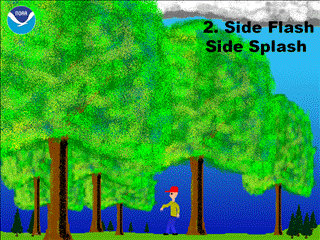
Ground Current
Injuries related to ground currents are the most common, accounting for roughly half of all incidents.
Ground current occurs when lightning strikes another object, and the current travels along the ground seeking a lower resistance circuit. The ground, in practice, is not a perfect conductor.
Let's say lightning strikes a pole in a parking lot or elevated terrain like a hill. The current will flow through the path of least resistance toward the area with the most negative charge, which could be located at a distance. Anything in the way of that current, such as a person standing on the ground, could shunt the current flow through them. Ground current, due to its capacity to cover large distances and areas, is a common cause of lightning-related fatalities and injuries, particularly among large farm animals.
Sometimes, the ground current from a lightning strike can reach such high levels that it fuses mineral grains together, forming Fulgurites.
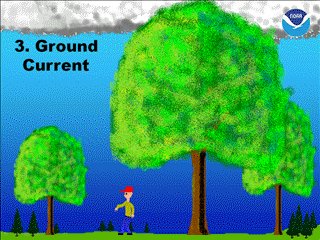
The greater the distance between the contact points, the higher the electrical potential difference. This can be extremely dangerous if that path of current through a body includes the cardiovascular and/or nervous systems.
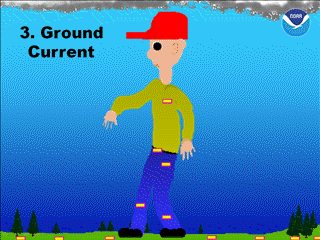
Contact Injury
Since lighting will take the path of lowest electrical resistance, it can travel long distances in wires or other highly conductive surfaces. When a person touches an object that is carrying current from lightning and it provides a pathway to electrical ground, they may experience an electric shock.
This list includes metal wires, plumbing fixtures, outdoor connections, electrical devices, faucets, phones, windows, and doors on anything conductive that is in the path of lightning current flow.
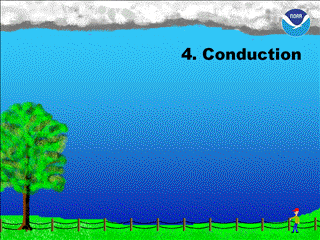
Blast Injury
While it may not be a primary mechanism of injury, it's important to note that primary and secondary blast injuries are possible.
When lightning strikes, it generates a high-current surge that rapidly heats up the air in the lightning channel, transforming it into plasma. The plasma is extremely hot and expands explosively into the cooler surrounding air, resulting in the creation of a cylindrical supersonic shock wave of high pressure that moves outward from the lightning channel. The barotrauma caused by lightning's pressure blast wave has been known to tear and tatter clothing, fracture long bones, rupture eardrums, and damage lungs. There has even been some research attempting to simulate its effects.
There also exists a documented case of secondary blast injury resulting from lightning, wherein high-speed shrapnel caused by an explosion hit the victim. As the story goes, a small wire segment measuring 2 cm went through the front of the chest, leaving behind a tiny puncture wound. However, internally it caused a lung laceration resulting in hemopneumothorax and got stuck in the back of the chest. The wire had to be removed through a thoracotomy, and fortunately, the patient had a successful recovery.
Lightning is scary; can I move somewhere else?
Well, the good news is that lightning-related deaths have significantly decreased in the past century, with recorded data showing a decline from approximately 400 fatalities per year to less than 30 in recent times.
A large factor was the movement of the population from rural communities to urban centers as well as the improvements made to lightning safety in man-made structures as well as lightning safety education.
To get a better idea of the impact of lightning strikes on the contemporary United States, you can analyze and compare the maps below for a clearer picture.
This is a map of cloud-to-ground lightning flash data from the U.S. National Lightning Detection Network 2015-2020
We can then contrast that with a map of how many lightning-related deaths each state has encountered over a similar period. Interestingly, in the United States, males aged between 20 and 45 constitute a larger percentage (84%) of total deaths. Although the statistics may show a low probability, none of that data matters if you happen to be the one who was hit.
Another way to ask the question about lighting risk is based on where it causes the most damage. According to FEMA, the following is a map of the Lightning Risk Index of counties in the US. This index calculates the likelihood of a lightning strike balanced by the community's ability to recover from it.
Factors That Contribute to Lightning Fatalities
John Jensenius from the National Lightning Safety Council conducted a study on lightning-related fatalities in the United States over a 13-year period.
In that study, I came across a section that caught my attention. It ranks the activities - both work-related and leisurely - that the victim was engaged in when the fatality occurred. It is interesting to note the top twelve activities, as shown in the table below.
Living in Southern Oregon, where we're blessed with many streams and rivers, I certainly paid attention to the fact that fishing was responsible for approximately 10% of lightning-related deaths, often the result of direct strikes
Although the report did not suggest that the activities themselves were any riskier than others, it identified four major factors that contributed to the lightning fatalities.
Vulnerability of the activity
Willingness to cancel or postpone activities
Being aware of approaching or developing storms
Ability and willingness to get to a safe place quickly
Based on my personal experience, these factors are spot on. People are often less likely to cancel an event due to potential thunderstorms than they would if there was heavy rainfall.
In a few cases, the victims were, in fact, taken by surprise by lightning strikes. Perhaps the presence of mountains or trees obstructed their view of the sky, leaving them unaware of an approaching storm until it was too late. But this was not the norm. Too often, they failed to take timely action to reach safety, or they also lacked a plan or the willingness to cancel the activity in time to reach a secure location.
I suggest reading the later part of "Shattered Air", a non-fiction story of a group of hikers who attempted to climb Half Dome and got caught in a thunderstorm.
Lightning Safety Guidelines
As with so many other outdoor activities, it certainly makes sense to have a plan to mitigate the risks associated with lightning.
The National Lightning Safety Council and the National Weather Service are continuously working towards making people aware and reducing lightning-related deaths.
While OSHA now requires construction sites to have an Emergency Action Plan (EAP), a large number of organizations have also made excellent efforts to provide lightning safety guidelines for coaches engaged in outdoor activities. The following are a few examples I came across during my research:
All of them have the following items in common:
The existence of a documented lightning policy
Specific staff assigned to monitor local weather conditions before and during events.
Criteria for suspending and resuming activities.
An evacuation plan, including identification of appropriate nearby shelters
I really appreciate how these practices promote the creation of a written plan, ensuring clarity and avoiding confusion about necessary actions.
While sports stadiums and campuses can make use of specialized hardware to detect lightning early, lightning alert apps available for iPhone and Android are a way to provide similar lightning warnings for small groups and individuals
Out of all the suggestions, my personal favorite is the 30-30 rule.
Once thunder is heard or lightning is seen, it means that the thunderstorm is nearby, and there is a risk of getting struck by lightning. Suspend any outdoor activity for at least 30 minutes and move to the designated safer location without delay.
Once the activity has been suspended, wait at least 30 minutes after the last thunder is heard or lightning is witnessed prior to resuming.
The premise of the 30-second rule is that sound which travels about 5 miles a second in dry air, and the general FAA guidance about staying 5-6 miles away from a thunderstorm. If the time between seeing lightning and hearing thunder is less, the storm is within 6 or so miles. than 30 seconds
I looked but was not able to find any specific guidelines for Search and Rescue groups. They could certainly benefit from many of the same guidelines employed by the coaches of sports organizations above. I particularly like the use of the alert apps as well as the incorporation of the 30-30 rule as well as training to identify appropriate nearby shelters.
When Thunder Roars, Go Indoors
When lightning is imminent, the best course of action is to get out of the open and seek shelter in a substantial building or fully-enclosed metal-top vehicle.
Buildings that are considered substantial do not include open structures like porches, gazebos, baseball dugouts, and sports arenas.
What about tents? While a tent may shelter you from rainfall, it does not provide any defense against lightning strikes. Additionally, the metal poles or frames of the tent could get hot enough to cause a fire. I have heard that a few companies were working on creating tents that are resistant to lightning strikes. These tents feature poles with specialized angles that redirect the lightning strike away from the tent and into the ground. However, none of these designs have been released for production yet.
In my research, I did come across some larger fabric structures available that come with lightning protection systems.
The CDC also has some helpful guidelines for staying safe from lightning while indoors.
Avoid contact with water during a thunderstorm. Do NOT bathe, shower, wash dishes, or have any other contact with water during a thunderstorm. Lightning can travel through plumbing.
Avoid using electronic equipment of all types. Do NOT use anything connected to an electrical outlet, such as computers, laptops, game systems, washers, dryers, or stoves. Lightning can travel through electrical systems and radio and television reception systems.
Avoid using corded phones. Corded phones are NOT safe to use during a thunderstorm. However, cordless or cellular phones are safe to use during a storm.
Do NOT lie on concrete floors or lean on concrete walls during a thunderstorm. Lightning can travel through metal wires or bars in concrete walls or flooring.
The bottom line is that there are no reliable places outside to be safe from lightning. But there are some things we can do to make the best of a bad situation.
Can I get a jump start?
Although being inside a building is the safest option during a lightning storm, being in a closed vehicle is still a safer alternative compared to being outside. The metal shell of a pickup truck or metal-topped car acts as a Faraday cage and should disperse the lightning around and to the ground, reducing the risk of harm.
It’s also advisable to refrain from rolling down the windows, touching electronic equipment (like the radio), or leaning on the metal doors of the vehicle as well as parking away from tall objects such as trees, electrical poles, metal fences, or scaffolding.
Notice I used the term "metal-top vehicles" to clarify that I am referring only to vehicles that have metal roofs. This excludes golf carts, ATVs, cars with plastic or fiberglass bodies, convertible cars, and open excavation equipment, which are not safe from lightning strikes.
A 1940's experiment showing how cars are safe from lightning.
What if I am stuck outside
As someone who loves being outdoors, I understand that there may be times when seeking shelter indoors during a lightning strike is not an option.
It's important to recognize that lightning strikes simply are unpredictable, and even with the necessary precautions in place, the risk of being struck can only be reduced by about 50%. These precautions are a last resort when all other options have been exhausted.
Let's examine our options and see what we can do to minimize our risks.
The CDC suggests the following steps.
Get off elevated areas such as hills, mountain ridges, or peaks.
Never shelter under an isolated tree. (side splash) If you are in a forest, shelter near lower trees.
Never use a cliff or rocky overhang for shelter. You could be in the path of ground current.
Immediately get out of and away from ponds, lakes, and other bodies of water.
Stay away from objects that conduct electricity (such as barbed wire fences, power lines, or windmills).
If you look around the internet, you will still find a lot of sites that still recommend the recommending the lightning crouch. I am removing this from the list.
Roeder (2009) did a good analysis of this and concluded that even if you had enough warning of an impending direct strike (which is unlikely), maybe it’s 52.6% better. Even the National Weather Service (NWS) stopped recommending the crouch because it gave people a false impression of safety.
The bottom line is that being out in lightning is a high-risk activity, so have a plan to get to shelter.
Injuries from Lightning
While prevention is the most effective approach to addressing lightning strike injuries, it is still possible for incidents to happen. Therefore, we must remain ready to manage them when they do occur.
I will limit my discussion of treatment to the scope of practice of a wilderness medical responder at the EMR/EMT level.
In the process of researching the topic, I found that the chapter titled "Lightning Related Injuries and Safety" from Auerbach's Wilderness Medicine (7th edition) was the most thorough and informative source available on this topic.
I also recommend looking over the Wilderness Medical Society Practice Guidelines as well as the Christian Hospital EMS Field Treatment Guidelines, they provide plenty of references to follow too.
There are three ways in which lightning can directly cause injury.
Electrical shock
Secondary heat production
Explosive force
Because of the instantaneous nature of lightning contact, the injuries sustained often differ from those caused by high voltage.
Lightning's high-frequency pulse often results in a surface flashover, with minimal energy passing through the body, particularly in the cases of sideflash or contact strikes. Even so, any electric current passing through the torso or brain can result in stopping the heart or the ability to breathe.
With lightning strikes, it has often been found that the heart will recover on its own, but it may take longer for breathing to return to normal. But if the cardiac or respiratory arrest is not quickly restarted, hypoxia can occur, which can complicate recovery. In addition, current passing through the tissues can cause a variety of nervous system issues, such as numbness and paralysis.
The passage of an electric current through a conductor, such as skin, produces enough heat to create burns since much of the current travels over the skin rather than through the body. The burn injuries are often linear, punctuate, or possibly feathering patterns. The linear burns are usually first or second-degree in nature and are possibly caused by steam burns caused by vaporizing sweat or rainwater. Burns can also be caused by ignited clothing or heated metal like belt buckles or jewelry. The lightning flashover has also been known to follow bodily fluids into orifices like the eyes or ears.
The current traveling through the nervous system may result in severe muscle spasms, which could cause the individual to suddenly jump, fall, or even suffer from bone fractures.
People who are wet may experience a higher probability of flashover with electrical current passing over their skin rather than through their body, potentially lowering the risk of major injury.
As we discussed earlier, the pressure blast wave from lightning can cause barotrauma similar to explosive injuries. This usually affects organs that contain air or gas, such as the ears, lungs, and intestines. The blast wave has the potential to cause both direct and indirect injuries, including fractures and damage to soft tissue.
In addition, there is a risk of experiencing brain injury, which could lead to symptoms such as altered consciousness, confusion, disorientation, or amnesia. There are also a variety of potential behavioral issues, as well as endocrine system problems and sexual dysfunction.
Assessing & Treating Patients with Lightning Injuries
It is important for rescuers to understand that victims struck by lightning do not have a residual current and are safe to touch. Rescuers should not be afraid to check for responsiveness. But as always, patient and rescuer safety is of utmost importance, as there is always a possibility of a repeat strike. As always, in situations where patients are located in highly dangerous areas, the rescuer must consider the risks and may need to wait for the storm to subside before providing treatment.
Individuals with the following high-risk indicators should be evacuated immediately after the scene is determined to be safe for rescuers.
Suspected direct strike
Loss of consciousness
Focal neurologic (nerve, spinal cord, or brain) complaint
Chest pain or dyspnea
Major trauma defined by Trauma Score < 4
Cranial burns, leg burns, or burns > 10% Total body surface area (TBSA)
Pregnancy
Lower-risk lightning injuries and other casualties should be triaged and evacuated based on their injuries and overall medical condition.
Lightning injuries are often witnessed, but they may also be suspected when a person is found outside unconscious or with amnesia during or shortly after a thunderstorm. When assessing the patient, the rescuer should continue to follow their standard protocol, including considering stabilization of the spine.
Rescuers should assume that if the victim is unresponsive with no breathing or limited breathing, it is most likely that they suffered a cardiac arrest. In this case:
Activate EMS immediately
Begin CPR with a CAB (Chest compression, Airway, Breathing) sequence.
Even if the heart resumes activity, there is a possibility of a secondary cardiac arrest occurring.
Monitor closely for any signs of cardiovascular, respiratory, or neurological collapse.
If a pulse is detected, ventilation should be maintained until the victim is able to breathe on their own adequately.
Rescuers should be prepared to provide prolonged rescue breathing.
Rescuers should also perform a thorough head-to-toe survey to assess for head, spinal, long bone, or cardiac injuries. Check peripheral pulses, sensory and motor status, and examine the skin for small or hidden burns. Remove smoldering clothing, shoes, and belts to prevent further thermal damage.
According to the AHA, patients with electric burns on their face, mouth, or anterior neck may have difficulty establishing an airway; extensive soft-tissue swelling can quickly develop, making it challenging to control the airway. The ACLS rescuer should consider early intubation for patients with extensive burns, even if the patient has begun to breathe spontaneously.
In cases with multiple victims, rescuers should employ a reverse-triage approach; "resuscitate the dead" is the rule for lightning incidents. The current recommendation is to prioritize focus on the victims that appear to be unresponsive because proper resuscitation can potentially lead to recovery even though burns or injuries may need treatment. Victims who are conscious or breathing spontaneously are already on the road to recovery.
Always evacuate any person struck by lightning and monitor for lingering physical or neurological symptoms that may need additional assessment and care.
That was a lot of words
Let's keep it simple:
Monitor local weather conditions before and during events.
Detect lightning early - get a lightning alert app on your phone.
Have a plan; where are the best nearby shelters?
Get out of the open, and seek shelter in a substantial building or fully-enclosed metal-top vehicle.
Apply the 30-30 rule
Epilogue
When all else fails, consider investing in a personal Faraday cage.
As I conclude this article, I want to share one more thunderstorm pro-tip from Joy of Cooking that you might ponder upon.
References and Resources
Auerbach's Wilderness Medicine - the most comprehensive treatise on the subject I have found.
Roeder, W. (2009). Last-minute outdoor lightning risk reduction
Taussig HB. “Death” from lightning and the possibility of living again.




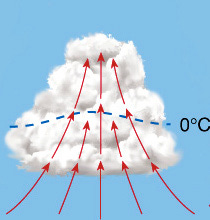

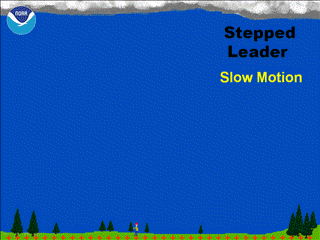

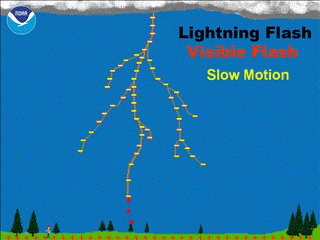





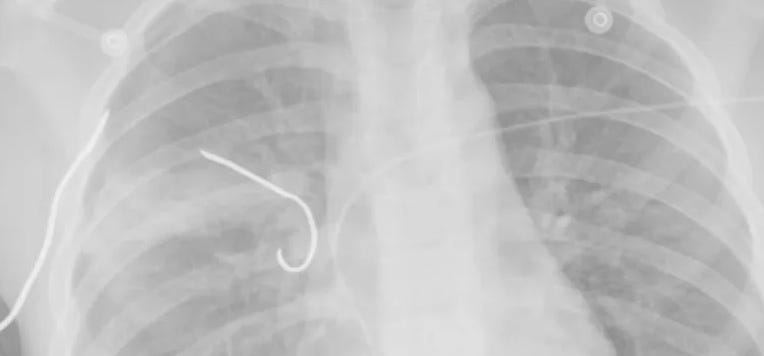









https://x.com/amazlngnature/status/1900145197746401522?s=61